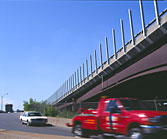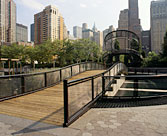Materials Suitable for Hot Dip Galvanizing
Most ferrous materials are suitable for hot dip galvanizing. Cast iron, malleable iron, cast steels, hot rolled steels and cold rolled steels all can be protected by hot dip galvanizing. Structural steel shapes, including those of high strength low alloy materials, are hot dip galvanized after fabrication to obtain the long lasting protection afforded by the zinc coating.
Though most ferrous materials can be hot dip galvanized, the characteristics of the galvanized coating will be primarily a function of the chemical composition of the material.
The galvanized coating has as its basis a reaction between steel and molten zinc resulting in the formation of a series of zinc-iron alloy layers, which are normally covered by a layer of solidified zinc. For most hot rolled steels the zinc-iron alloy portion of the coating will represent 50 to 70 percent of the total coating thickness.
Steel compositions vary depending upon strength and service requirements. Major elements in the steel, such as carbon silicon, affect the necessary galvanizing techniques as well as the structure and appearance of the galvanized coating. For example, certain elements, when present in the steel, may result in coating that is all, or nearly all, zinc-iron alloy.
While a description of the mechanism that causes this type of coating is beyond the scope of this manual, a description of the characteristics of an all or nearly all zinc-iron alloy coating is listed below:
Visual - Visually, the zinc-iron alloy coating may have a matte gray appearance due to the absence of the free zinc layer. It is the free zinc layer which imparts the typical bright finish to a galvanized coating.
Adherence - The coating which is all or nearly all zinc-iron alloy may have a lower adherence when compared to the “typical” galvanized coating. This type of coating tends to be thicker than the “typical” galvanized coating. As the thickness of this type increases, a reduction of adherence may be experienced.
Corrosion Resistance - In general, galvanized coatings are specified more for their corrosion resistance than for their appearance. Thus, designer’s primary interest is the relative corrosion resistance of the two coating types. Fabricators and consumers should be aware that while a gray or matte appearance may occur, this matte appearance does not reduce the long term atmospheric corrosion protection of the steel. For all practical purposes the corrosion resistance, mil for mil, of these coatings is equal.
It is difficult to provide precise guidance to the designer in the area of steel erection without qualifying all of the grades of steel commercially available. The guidelines discussed below, however, will usually result in the selection of steels having good galvanizing characteristics:
- Plain carbon structural grade steel will, under most circumstances, galvanize with the production of a typical coating. However, it is known that levels of carbon less than 0.25%, phosphorous less than 0.05% or manganese less than 1.35% are beneficial.
- Silicon at levels less than 0.04% or between 0.15% and 0.25% is desirable.
Silicon may be present in many steels commonly galvanized even though it is not a part of the controlled composition of the steels. This occurs primarily because silicon is used in the de-oxidation process for the steel and is commonly found in continuous cast steels. Steels containing the higher silicon levels may be exhibit bright, shiny areas adjacent to gray matte areas, due to the silicon distribution. A recognized method to combat the effects of high silicon steel is to add a trace amount of nickel, usually between .05 - .09% to the zinc bath.
The galvanizer should always be advised of the grade of steel selected in order that he might determine whether or not special galvanizing techniques will be required.
Combining Different Materials and/or Surfaces
Optimum galvanizing quality is seldom obtained when different surface conditions, different fabricating methods, or ferrous metals with different chemistries are combined.
This is because different parameters for pickling (solution concentrations, temperatures, immersion time) are required for:
- excessive rusted surfaces
- pitted surfaces
- machined surfaces
- cast iron (especially with sand inclusions)
- cast steel
- malleable iron
- hot rolled steel
- cold rolled steel
- steels containing more than normal carbon, phosphorous, manganese and silicon.
- The use of old and new steel or castings and rolled steel in the same assembly should be avoided, when possible. Where assemblies of cast iron, cast steel, malleable iron and rolled steel are unavoidable, the entire assembly should be thoroughly shot or sand blasted prior to pickling in order to produce a galvanized coating of acceptable quality.
Excessively rusted, pitted or forged steels should not be used in combination with new or machined surfaces because difference in required pickling time can cause over pickling of the machined surfaces. Where this combination is unavoidable, through abrasive blast cleaning of the assembly (normally before any machining is done) will remove rolled-in mill scale, impurities, and non-metallics prior to pickling. Products containing different ferrous materials will then pickle in a more uniform matter, providing an optimum galvanized coating.
Omission on blast cleaning of mixed material assemblies will result in combined under-and over-pickling of the different surfaces. This omission may adversely affect the quality of the galvanized coating.
Whenever possible, the materials described should be galvanized separately and assembled after galvanizing. Whenever steels of different chemical composition or different surface finishes of steel are joined in an assembly, the galvanized finish is generally not uniform in appearance. The corrosion protection provided by the galvanized coating, however, is not affected by variations in color and texture of coating.
When abrasive blast cleaning is used to prepare a surface for galvanizing, a coating thicker than the normal galvanized coating will be produced. Abrasive cleaning rough-ens the surface and increases its surface area. The result is an increased reactivity with the molten zinc. Greater zinc-iron alloy growth occurs during galvanizing of a blast-cleaned steel, producing thicker coating at the expense of a moderately rougher surface. These thicker coatings will sometimes have a dark gray appearance because the alloy layers may extend to the outer surface.
Combinations of steels of different compositions may result in different compositions may result in different coating thicknesses and surface appearances. This is not necessarily detrimental to certain applications, but the designer and fabricator must consider this an, in the planning stage, should consult with a galvanizer.


